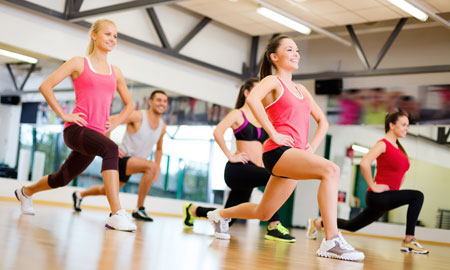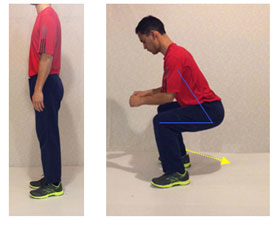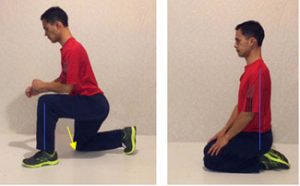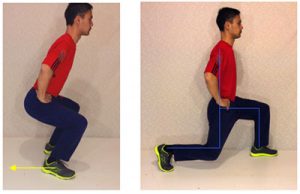You Should Lunge To Prevent Back Pain
By Sherwin Nicholson | Updated May 7, 2020

No gym necessary. You can easily do it around the home.
Why should we lunge to relieve the pain?
How exercise for your leg muscles can help your spine?
Shouldn’t I exercise my back instead of my legs?
Not really. Using your leg muscles more matters! The biggest factor for lunges and pain relief is with your HIPS and LEGS.
In fact, it is a big mistake to strengthen your back as your first option because it is already tense and most likely too strong. In many cases, your back muscles are tightening up too much and are adding to your tension and discomfort.
It’s the rest of your body that is the problem! Lunging gives you the proper stability and support needed for your hip and pelvis.
Did you find that you may have cringed at the thought of having to do it to help stop your pain? Well, the sad news is that if you don’t like to lunge or even squat, then you most likely have found your cause. It may sound harsh but it’s the truth.
Remember this rule! The more active and stable your hip and pelvis are, the more stable your spine will be. More stability means less pain.
By exercising this way, your hip muscles are activated and recruited to function to help your body remain upright, aligned and level.
The time that you had to lunge but didn’t want to
Do you remember what you had to do when you had that back spasm, pulled muscle or really stiff back?
You know, when you needed to lean over or get lower to the floor in such agony but couldn’t. Yes! You lunged to lower yourself! It was too painful to lean over so you needed to bend your legs as much as possible.
This is what you should be doing before any injury occurs in the first place.
Lunges are often neglected
Unfortunately, lunges are the least performed exercises among the more popular leg exercises. They are sometimes believed to be less as important to practice as squats, cycling or running as a choice for leg conditioning.
However, by adding it to your daily routine, you will be able to perform ALL activities more effectively, efficiently and with more power.
Almost every exercise and activity requires the healthy movement and power that lunges provide.
Any activity that requires you to lower your body closer to the ground should incorporate this action at the very least. In fact, we can avoid these injuries from many daily activities at home and away.
Avoiding it may come at a cost
The pain only becomes more frequent when you don’t train your body to use your legs as you bend down. Most of us would rather lean over or bend forward instead of bending at the knees and hips. You can avoid spasms by avoiding this bad habit.
It’s common to lean and bend where there is no pain. It certainly feels less tiring and easier. However, the risk is that you’ll very likely trigger a back spasm
If this is the case, then lunging would be less preferred than bending. This, of course, comes at the expense of your lumbar discs, since bending causes the most injury of all possible movements.
After repeating this mechanically risky movement hundreds or thousands of time over many years, back spasm, disc bulge, rupture, and degeneration are very likely to occur. A sure sign of this problem is pain in the morning.

What Lunges Exercise:
Rectus femoris
Vastus lateralis
Vastus medialis (not shown)
Vastus intermedius (not shown)
Gluteus maximus
The first four muscles make up the Quadriceps. The Gluteus maximus should be the primary active muscle when you lower or raise yourself. It is the glute that extends the leg muscle.
An active glute allows the pelvis to become stable and keeps your pelvis upright and aligned with your spine. By tilting at the hip joint and not the spine, you will reduce your risk of disc injury.
With practice, you will find it more natural to enter this position instead of by bending over. Initially, it will be difficult to perform because you have not been practicing this movement regularly.
You’ll find it hard to do at first because your glute muscles will feel very weak and unstable.
If you find that you are contracting your thighs more than the muscles of your buttocks, you’re not properly activating the primary glute muscles. An inactive glute leads to many mechanical problems that hurt!
Steps to practice the Lunge
If you currently have chronic pain, chances are you will not be able to perform it correctly. You may even become discouraged and avoid it altogether. Holding a squat position may feel tiresome. To prevent this from occurring, start the following way:
- Start practicing by lowering your body as if to perform a half squat.
- Hold this squat position anywhere for a few seconds or longer depending on your endurance and comfort.
- Return to a standing position.
- Practice this frequently until you find it easy to perform.

Begin a reverse lunge by place one foot in behind of you. If you need to, keep your hands on a support to prevent from leaning to the sides excessively. Try to lower yourself until your thighs are parallel to the floor.
If you prefer, you can even lower yourself further to a kneeling position. Rest.
- Step upward with one leg to raise yourself up to a squat.
- Bring the other leg forward and even with the other thigh.
- Stand up straight.
For those with well-conditioned leg muscles, this is a very easy task. For those with chronic pain, it is much more challenging. The hips will not move evenly and level.
Many muscles will feel strained and weak.  This weakness makes for an uneven movement causing one to lean off balance with raising and lowering.
This weakness makes for an uneven movement causing one to lean off balance with raising and lowering.
Experiencing this problem is natural. It will take time and practice before you will be able to do it more effectively and easily.
Incorporate lunges into your everyday routine and you will find yourself doing it naturally and preferably.
When your legs become stronger, you can increase the difficulty by stepping further apart as you move. You can do this by stepping one leg further behind and even further to the side.
Don’t just stop at lunging! There’s more to help you:
What you need to know about tight hip flexors and your back
Your glutes are a major pain in the butt and back
Do I really need to exercise when I am already sore?
Sherwin, get me the program to help me lunge!
References:
Effects of Stabilization Exercises on Health-Related Quality of Life in Women With Chronic Lbp. – Moussouli M(1), Vlachopoulos SP, Kofotolis ND, Theodorakis Y, Malliou P, Kellis
LBP in Athletes – Javad Mortazavi 1 ; Jayran Zebardast 2 ; and Babak Mirzashahi 1, *1 Joint Reconstruction Research Center, Tehran University of Medical Sciences, Tehran, IR Iran2 Imam Khomeini Hospital Complex Asian Journal of Sports Medicine. 2015 June; 6(2): e24718 , DOI:
Exercise as a treatment for chronic lbp – James Rainville, MDCorrespondence information about the author MD James Rainville Email the author MD James Rainville, Carol Hartigan, MD, Eugenio Martinez, MD, Janet Limke, MD, Cristin Jouve, MD, Mark Finno, MDmDOI: http://dx.doi.org/10.1016
